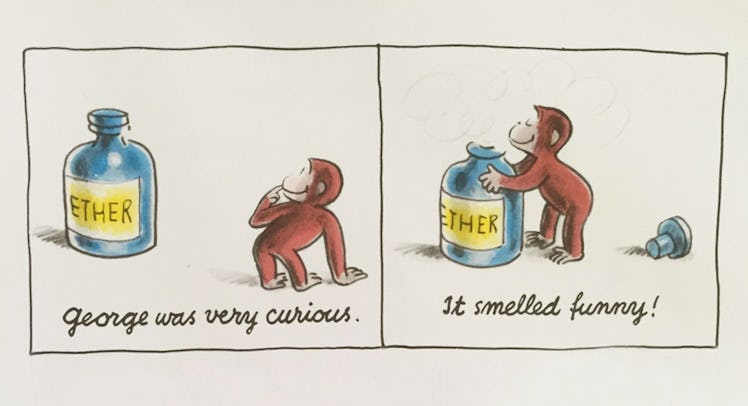A Look Back At That Time Curious George Huffed Ether
Monkeying around.

One of the stranger pages in children’s literature involves a certain inquisitive primate and a powerful sedative. After a big adventure that involved window washing, guerilla apartment painting, and a tumble from a tall building, Curious George finds himself recovering from a broken leg in the hospital. Wandering around the ward, he spies a bottle of ether, and, probably due to his eponymous craving for knowledge, cannot resist opening and sniffing it. Suddenly, the book tells us, “his head began to turn, then he felt like he was flying, then rings and stars danced before his eyes, then everything went dark.”
Thanks to an ice cold shower under the watchful eyes of a fast-thinking nurse and his guardian, The Man With the Yellow Hat, George is able to return from the brink of consciousness and wrap up his adventure in style (quick visit to the movie studio to star in his own biopic, packed theater full of animal friends, all’s well that ends well). The book doesn’t dwell on it, but why exactly does our favorite 2-foot tall monkey inhale a drug that can cause muscle spasms and long-term neurological impairment?
Diethyl ether is one of the oldest anesthetic compounds around. Originally used to put patients under for surgery in the 1840s, it was hailed as a miracle substance. For the first time ever, it was possible to operate on a fully unconscious subject. Doctors loved ether for its high therapeutic index, which means there’s a big difference between a therapeutically effective dose and a toxic dose. Today, anesthesiologists use a complicated blend of drugs to induce unconsciousness, but for several decades from the late 19th to mid 20th centuries, ether reigned supreme. As it became an essential drug around the world, it gained popularity among casual users who enjoyed its intoxicating effects.
Wikimedia Commons
It’s easy to forget now, but ether was a top recreational drug choice for almost 100 years. It was especially beloved in Central and Eastern Europe, where it was thought of as a safe alternative to alcohol. Immigrants brought it to American cities, where small amounts could be purchased at the corner drugstore. Ether permeated high and low culture alike: it’s one of the few substances to get big shoutouts both in War and Peace and Fear in Loathing in Las Vegas, where it’s included at the tail end of Hunter S. Thompson’s famous laundry list of drugs and given special recognition:
“The only thing that really worried me was the ether. There is nothing in the world more helpless and irresponsible and depraved than a man in the depths of an ether binge.”
Which brings us back to our boy George. To a mid-century reader, ether inhalation would have been an instantly identifiable gag. For proof, look no further than the classic Bugs Bunny cartoon “Water, Water Every Hare.” The 1952 short, which came out just five years after Curious George went on his big trip, involves Bugs getting chased by a mad scientist who wants his brain. The scientist throws an axe at the wily rabbit, but misses and breaks open a bottle of ether. The rest of the chase proceeds in slow motion, to the tune of a chopped and screwed William Tell Overture. After a few seconds, both the hare and the scientist are stone cold unconscious.
Contemporary readers would have gotten a kick out of George’s ether follies that might be a bit lost on today’s youth. Nevertheless, this is a great opportunity to introduce your kid to the concept of substances that they’re best off avoiding. Curiosity may not have killed the monkey, but there are some bottlecaps better left unscrewed. And you might want to wait a few years on the Hunter S. Thompson.